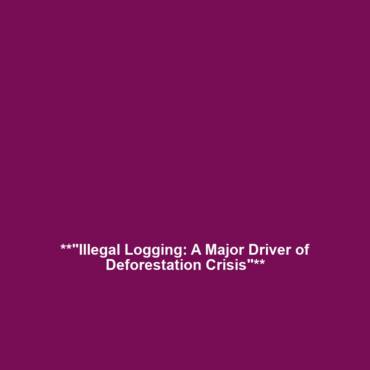Deforestation Driven by Illegal and Unsustainable Logging Practices
Introduction
Deforestation driven by illegal and unsustainable logging practices poses a significant threat to global biodiversity. As forests are vital ecosystems, their degradation through unlawful activities not only leads to habitat loss for countless species but also exacerbates climate change impacts. This article delves into the urgent issue of deforestation and its consequential effect on biodiversity loss, highlighting the need for effective measures to curb illegal logging activities.
Key Concepts
Understanding Illegal Logging
Illegal logging refers to the harvesting of timber in violation of national laws and regulations. These practices often go unchecked, contributing significantly to deforestation rates. Major concepts related to this issue include:
- Unsustainable Practices: Methods that degrade forest ecosystems beyond viable recovery.
- Environmental Impact: The loss of biodiversity, soil erosion, and disruption of water cycles due to forest removal.
- Regulatory Challenges: Difficulty in enforcement and monitoring the legality of timber sources.
The Importance of Forests
Forests are essential for maintaining biodiversity. They provide habitat for numerous species and support ecological balance. Deforestation, fueled by illegal activities, threatens this balance, highlighting the urgent need for action.
Applications and Real-World Uses
Understanding how deforestation driven by illegal and unsustainable logging practices impacts biodiversity loss is crucial for developing practical solutions. Key applications include:
- Conservation Initiatives: Strategies aimed at protecting remaining forest areas through community engagement and policy reforms.
- Sustainable Forestry: Promoting logging practices that adhere to environmental standards to ensure long-term forest health.
- Restoration Projects: Initiatives aimed at reforesting degraded areas to restore biodiversity and ecosystem services.
Current Challenges
Despite increased awareness, several challenges persist in addressing deforestation driven by illegal and unsustainable logging practices:
- Regulatory Enforcement: In many regions, laws are inadequate or poorly enforced.
- Economic Incentives: Illegal logging can be lucrative, driving persistent engagement in these practices.
- Lack of Community Engagement: Local communities may lack incentives or knowledge to protect their forests.
Future Research and Innovations
Future research on deforestation driven by illegal and unsustainable logging practices is critical for developing innovative solutions. Potential breakthroughs include:
- Satellite Monitoring: Advanced technologies for tracking illegal logging activities in real-time.
- Blockchain for Timber Tracking: Innovative methods to ensure transparency in the timber supply chain.
- Community-Based Conservation: Engaging local populations in sustainable practices that protect forests.
Conclusion
Deforestation driven by illegal and unsustainable logging practices remains one of the most pressing issues threatening global biodiversity. Addressing this complex problem requires concerted efforts from governments, NGOs, and local communities. For further reading on sustainable forestry practices and conservation strategies, visit our related articles page. Together, we can take meaningful steps to combat deforestation and preserve our planet’s invaluable biodiversity.

Leave a Reply